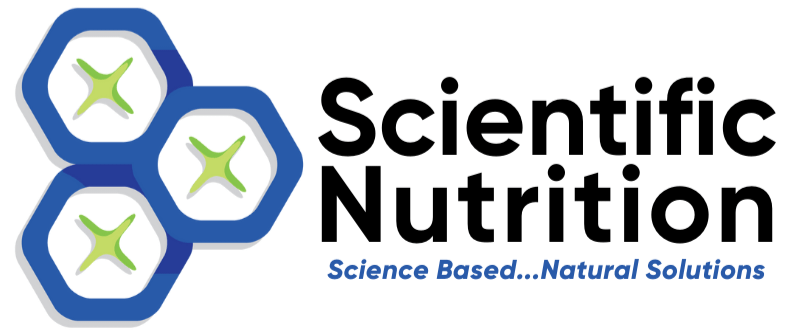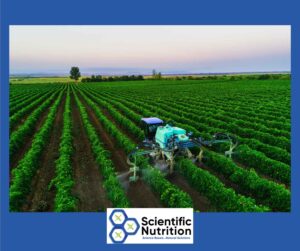Gallstones can quietly wreck your health.
Gallstones might be small, but the damage they cause can be massive. These hard deposits in your liver and gallbladder often go unnoticed until they trigger serious health problems. Ignoring early signs like digestive issues or unexplained fatigue could put your long-term health at risk.
The amazing fact about your body is that it speaks to you if something is wrong. All you need to do is pay attention. The same happens when your gallbladder has gallstones. In this post, you’ll learn to recognize these signals and discover what your body might be trying to tell you. Let’s explore more.
Is your body asking for a liver cleanse?
Your liver and gallbladder are crucial for detoxifying your body – filtering out harmful substances and breaking down fats. When gallstones form, these organs can’t function properly, which leads to various health issues. Signs of distress can show up in different ways, from digestive problems to skin changes.
Regular detoxification prevents gallstones and keeps your liver healthy. If you’re experiencing unusual symptoms like persistent fatigue, digestive discomfort, or changes in your skin, it could be your body’s way of telling you that a liver cleanse is overdue. Recognizing these signals early can make all the difference. The symptoms of gallstones can be as plain as the signs on your face or body.
Key signs and symptoms of gallstones in different parts of the body
Research has shown that the body often exhibits apparent symptoms when gallstones affect health. According to a study published in the BMJ, common symptoms include pain, jaundice, and changes in skin color, which can indicate issues with the liver or gallbladder.
A review in the journal Biomolecules highlights that these symptoms are critical indicators for diagnosing gallstone-related complications. Below, you will discover those signs.
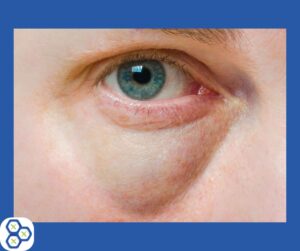
Signs of gallstones and your eye health:
Your eyes can reveal a lot about your liver and gallbladder health. Pay close attention to your eyes, and you will be able to spot early signs of gallstones.
- Puffy, watery skin around the eyes often indicates clogged eliminatory organs, lymphatic systems, or even gut imbalances (dysbiosis). Tumors inside reproduction tissues can be caused by chronic inflammation and lead to eye swelling.
.
- Cataracts can develop from a chronic digestive or liver condition, where protein and mucus build up over time due to a chronic digestive and liver condition. This isn’t just an aging issue—your gallbladder may struggle to function correctly.
.
- .Yellowing under the eyes signals deeper organ dysfunction. The darker the yellow tint, the more serious the issues could be in your digestive system, kidneys, or reproductive organs. Pale or flesh-colored areas may point to problems in the lymphatic, kidney, or lung systems.
. - Red eyes can indicate poor circulation or respiratory issues, where the blood lacks proper oxygen flow full of proper oxygen to the whites of the eyes. If you notice yellow patches on the whites of the eyes, this could indicate large gallstones stuck in the liver or gallbladder. Cysts and different tumors may be prevalent as well.
.
- A visibly thick line across the pupil iris is a clue that the lymphatic system is clogged with fats and high cholesterol.
.
Gallstone signs around the eye:
- The darker the shading the more serious the digestive, kidney, reproductive organs, and bladder issues. If pale or lack of flesh color you will want to care for your lymphatic, kidney, and pulmonary (lung) systems.
.
- Dull, tired-looking eyes can result from “dirty” blood, a sign that your kidneys or liver are struggling to filter out impurities, leading to poor circulation and congestion. It is a clear signal that there is reduced blood flow, and a congested kidney, and liver.
.

Signs of gallstones and your skin:
- Hair Loss in the middle and top of the head can indicate a congested pancreas, heart, small intestines, liver, or reproductive organs. Premature graying is a definite sign of under-active gallbladder and liver function. It is also due to excessive Calcium and Magnesium elimination in mass to calm the body as seen in Hair Analysis Results.
. - Freckles, age spots, dark patches on the sides of your forehead, brown patches, moles, under your eyes, or between the brows could be more than just cosmetic concerns. These marks are often called liver spots on the hands or forearms but may also be around the shoulder blades. They can indicate a build-up of toxins in the liver and gallbladder. These spots may even fade if you undergo a detox or cleanse.
. - A greenish or darker coloration on the sides of the bridge of your nose or temples indicates the pancreas, liver, spleen, and gallbladder are under-active.
. - Oily, sweaty, or discolored skin, particularly on the forehead, can signal bile dysfunction and a struggling liver. A yellowish tint to the skin may also be a sign that your gallbladder isn’t processing fats efficiently.
. - Wrinkles or vertical lines between the eyebrows—sometimes called the “11’s”—can point to a deeper liver toxicity. If these lines are prominent, it may mean your liver is clogged with toxins and needs support through detoxification. Hair growth between the brows and pimples is an indication that the spleen, gallbladder, and liver are clogged. These lines are not a part of “normal aging”.
.
.

Signs of gallstones and your nose:
Your nose’s shape, color, or texture indicates internal issues.
- A line, indentation, or enlargement on one side of your nose may signal a connection to heart enlargement on the corresponding side, or related conditions such as heart palpitations or murmurs. Even panic attacks might be linked to this, particularly if there’s an indent at the tip of your nose.
. - A hard tip or thickened skin on your nose often suggests an urgent need for detoxification. This could indicate that fats are accumulating in your liver, and blood vessels may become more visible as a result.
. - A red or purplish nose might indicate either too high or too low blood pressure imbalances. In either case, it suggests that your liver and kidneys need help to restore balance and proper function.
. - A nose leaning to the left can appear odd, but it may reflect issues with the gallbladder, liver, ascending colon, or even the right side of the brain or reproductive organs. This unusual sign highlights the need to clear gallstones and support these organs.
.
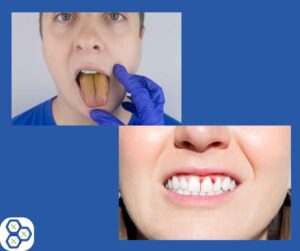
Signs of gallstones and your tongue:
Your mouth can reveal critical clues about your liver and gallbladder health. Like;
- A cracked tongue often indicates chronic colon dysfunction. This occurs when the colon’s walls suffer damage from acidic toxins, primarily due to insufficient bile volume to break down food effectively.
. - A yellow or white-coated tongue, especially towards the back, signals the presence of putrefied, fermented, or undigested food toxins. Lymphatic fluid can’t eliminate these toxins, leading to trapped acids and microbes.
.
- Tooth indentations on the sides of your tongue or whitish mucus indicate poor digestion and nutrient malabsorption in the small intestines.
.
Signs of gallstones and your mouth health:
- Swollen lips—with a protruding bottom lip signaling intestinal dysfunction and a swollen top lip pointing to stomach issues—can result from toxic acids and indicate dehydration down to the cellular level. Symptoms can include dry, peeling, or split lips.
.
- Dark spots or venous lakes (similar to blood blisters) on the lips indicate poor blood circulation and slow lymphatic drainage, suggesting potential lung, heart, and respiratory pathways are suffering from congestion.
.
- Frequent belching or chronic bad breath can stem from undigested and putrefied food in the digestive tract. Bacteria feed on fermenting food, producing toxic gases that rise up the throat—very different from (bad breath) halitosis caused by tooth decay.
.
- Acid reflux and bile burping can lead to persistent coughing or throat clearing as extra mucus forms to neutralize the acids and toxins.
. - Crusty corners of the mouth can suggest ulcers in the large intestine, while the outer lip may show signs of duodenal ulcers from bile regurgitating back up into the stomach. Severe inflammation and ulcers can occur in the intestinal wall, especially when the herpes virus presents cold sores on the lips.
. - Frequent cavities or yellowing canine teeth indicate a highly acidic diet rich in sugars, coffee, or soda, coupled with protein-heavy foods. Nutrient deficiencies linked to Hair Analysis results may be common, highlighting the relationship between gallstones and mineral imbalances. Unbalanced minerals and acidic yet minimal saliva contribute to this problem.
. - Bleeding gums, tonsillitis, or swollen gums can indicate lymphatic drainage issues clogging the head of the nodes that hinder the liver’s cleansing processes.
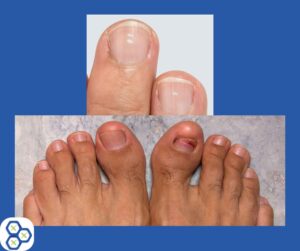
Signs of gallstones; your hands, nails, and toe health:
Nails and toes can reveal vital insights into your liver and gallbladder health.
You especially need to look at signs like;
- White spots on the nail bed often indicate a significant elimination of sugar or simple carbohydrates. They may also reflect a substantial purge of zinc or calcium during illness.
.. - Fatty, white skin on the fingertips suggests a diet high in excess fats and sugars.
. - A hardened tip or callous on the fourth toe may signal a stagnant gallbladder. Conversely, a stiff or painful bent toe indicates a chronic condition involving gallstones in both organs.
. - .Gallstones in the liver’s bile ducts can cause the big toe to bend towards the second toe. This occurs as the lymphatic system and spleen work overtime to compensate for poor digestion, waste byproducts, and the accumulation of metabolic toxins.
. - Dark red fingernail beds indicate elevated cholesterol levels, minerals, and fatty acids in the blood, suggesting sluggish excretory pathways. In contrast, white nail beds may signify poor circulation and the accumulation of fats and mucus around the liver, heart, pancreas, and reproductive organs, often in conjunction with anemia.
. - Yellow-colored feet strongly indicate significant gallstone accumulation in the liver and gallbladder. If you notice a greenish hue, this could suggest severe spleen or lymphatic system issues, possibly involving tumors or cysts.
. - Bumps or white toenails on your fourth and fifth toes can be linked to kidney, liver, bladder, and gallbladder congestion.
. - Vertical ridges on fingernails often signal poor digestion and nutrient absorption, which may contribute to ongoing fatigue. Prominent high ridges, especially those with split ends, may indicate poor circulation and digestion associated with ovarian and testicular disorders.
Hair Analysis and the signs of gallstones
If you notice any signs or symptoms of gallstones, it’s essential to take action. Ignoring these signals can lead to severe health consequences.
You have three choices:
- First, ignore the symptoms until they escalate into serious health problems.
- Second, play a guessing game, practice treating it, and try to “treat” it without professional guidance.
- Third, address the issue naturally by using Hair Trace Mineral Analysis to understand your body’s needs.
Many of my (wise) clients made the third choice, and they regained their optimal health.
Are you ignoring the signs and symptoms of gallstones?
Your health should be a priority. Take the first step towards understanding your condition and improving your well-being.
Schedule a complimentary chat today, and let’s discuss your health goals together!
Make yourself a priority for the best quality of health possible.
Learn more about How and why gallstones are formed.
Copyright Scientific Nutrition, LLC 2021
*Disclaimer (because we have to): Do not construe any information listed on this site as a substitute for actual medical advice. The information you receive from us is not intended to replace medical advice from your doctor. Scientific Nutrition, LLC does not dispense medical advice, prescribe, or diagnose illness. We offer nutritional programs and supplements that support your health. The views and nutritional advice expressed by Scientific Nutrition, LLC are not intended to be a substitute for conventional medical service.
